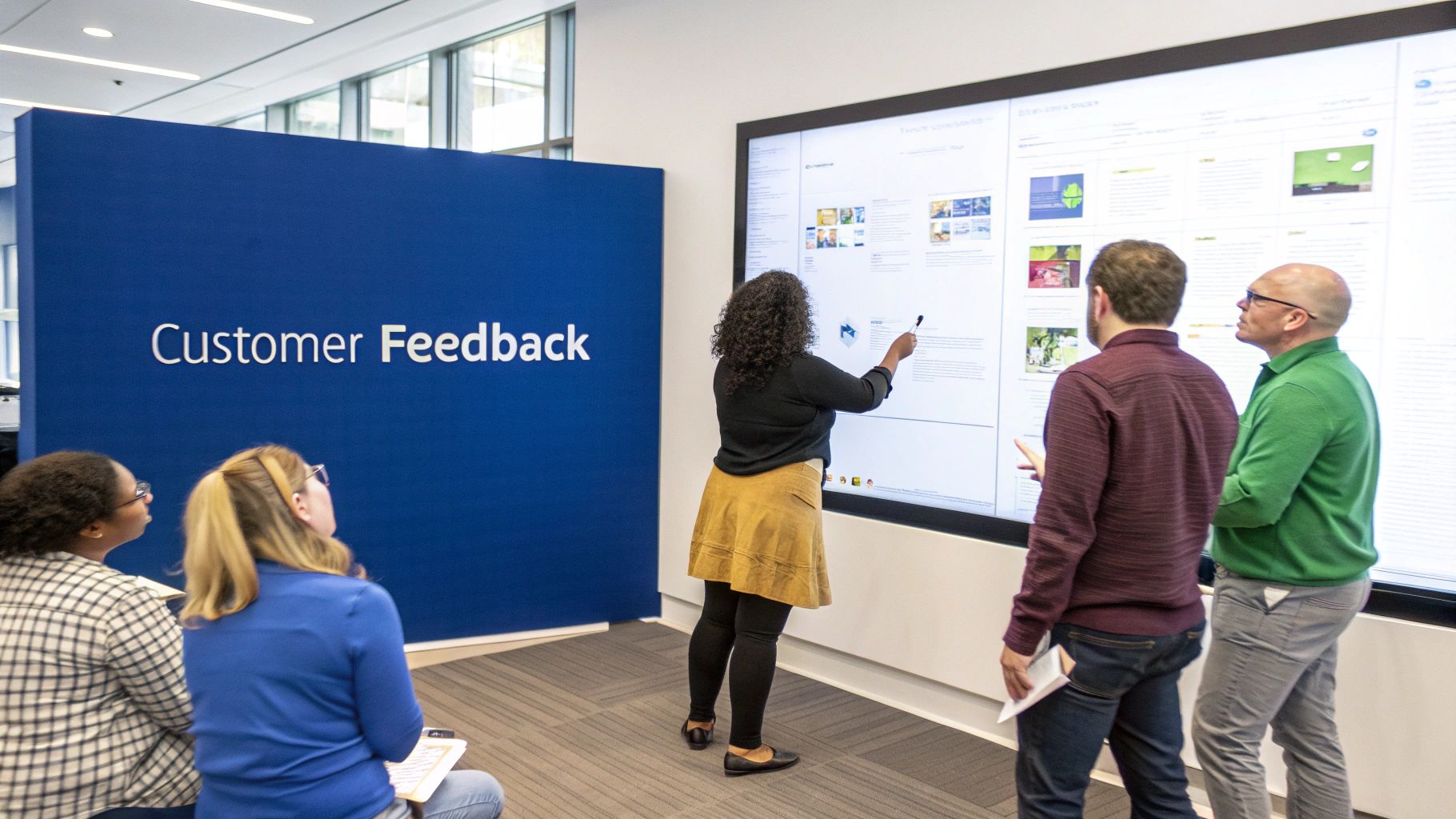In today's fast-paced market, the ability to adapt, innovate, and deliver value quickly is no longer optional; it's essential for survival. Traditional, rigid development models often struggle to keep up, leading to missed opportunities and wasted resources. This is where Agile methodologies come in. But what are the tangible agile software development benefits that drive businesses to adopt this transformative approach? From startups launching their first app to established enterprises in the healthcare or automotive sectors, organisations are leveraging Agile to not only build better software but to build better businesses.
This guide moves beyond the buzzwords to provide a detailed, actionable breakdown. To understand why Agile offers these advantages, it's helpful to compare its iterative nature to older, linear models. For a deeper dive into this comparison, explore the fundamental difference between Agile and Waterfall.
In the following sections, we will explore 10 critical benefits that explain why Agile remains a dominant force in modern software development. We will unpack how each benefit translates into real-world success, offering a clear path to enhanced productivity, superior customer satisfaction, and a stronger, more predictable bottom line for your organisation.
1. Faster Time to Market
One of the most significant agile software development benefits is the dramatic reduction in time to market. Traditional development models, like Waterfall, often require months or even years of work before a single piece of functional software reaches the end-user. Agile flips this on its head by breaking down large projects into small, manageable iterations called sprints, which typically last one to four weeks.

This iterative approach means a usable version of the product is available much sooner, allowing businesses to launch, gather real-world feedback, and adapt quickly. Companies like Spotify exemplify this by using two-week sprints to continuously roll out new features, staying ahead of market trends. This incremental delivery is core to agile, letting you seize market opportunities and gain a competitive edge while a complete product is still in development. Agile methodologies inherently aim for this speed by focusing on delivering value incrementally, such as through strategies for building a Minimum Viable Product (MVP).
How to Implement This Benefit:
To achieve a faster time to market, concentrate on a few key practices:
-
Prioritise the MVP: Focus initial sprints on core features that solve a primary customer problem. This gets a functional product into users' hands as quickly as possible.
-
Automate Your Pipeline: Implement Continuous Integration/Continuous Deployment (CI/CD) to automate testing and deployment. This minimises manual errors and speeds up the release cycle. To get started, you can explore guides on building a modern DevOps pipeline.
-
Maintain Open Communication: Use daily stand-ups and sprint reviews to ensure development, product, and business teams are aligned, removing roadblocks swiftly.
2. Enhanced Flexibility and Adaptability
A core tenet among agile software development benefits is its capacity for rapid adaptation. Unlike traditional methods that lock teams into a rigid, long-term plan, agile is built for change. It empowers teams to respond swiftly to shifting market demands, new customer feedback, or emerging business priorities. This is achieved by planning in short, iterative cycles, allowing for continuous re-evaluation and adjustment of the product's direction.

This ability to pivot is crucial in today's dynamic business environment. A prime example is Slack, which famously evolved from a failed gaming venture into a leading communication platform by responding to internal needs and market opportunities. Similarly, Instagram shifted its focus from a broad check-in app to a photo-sharing platform based on user behaviour. This adaptability, a foundational element of agile project management, prevents wasted resources on features that are no longer relevant, ensuring the final product truly meets market needs. For a deeper dive, you can explore this overview of agile project management basics.
How to Implement This Benefit:
To build greater flexibility into your development process, focus on these key agile practices:
-
Maintain a Dynamic Backlog: Keep the product backlog well-organised and consistently prioritised. This living document should reflect the most current business goals and customer needs.
-
Embrace Regular Refinement: Hold frequent backlog refinement and sprint planning sessions. These meetings are critical for discussing changes, re-assessing priorities, and aligning the team on the next steps.
-
Establish Clear Acceptance Criteria: Define clear, testable acceptance criteria for each user story. This provides a framework for flexibility while preventing scope creep and ensuring that changes add real value.
3. Improved Customer Satisfaction and Collaboration
Another key agile software development benefit is the deep and continuous collaboration with the customer, leading to significantly higher satisfaction. Traditional models often siloed clients until the final delivery, creating a high risk of misalignment. Agile methodologies integrate the customer directly into the development process, transforming them from a passive recipient into an active partner. This ensures the final product truly reflects their evolving needs and business goals.

This collaborative approach means customers see and interact with working software at the end of every sprint, offering regular feedback that steers the project in the right direction. Companies like Salesforce excel by maintaining close partnerships with customers throughout their agile development cycle, ensuring their CRM platform continuously evolves to meet real-world demands. This level of engagement builds trust and a sense of shared ownership, resulting in a product that genuinely solves the customer's problem and a much stronger client relationship.
How to Implement This Benefit:
To foster greater customer satisfaction through collaboration, focus on these actionable steps:
-
Empower the Product Owner: Designate a Product Owner who acts as the direct representative of the customer. This individual must have the authority to make decisions on behalf of the client to keep the development process moving smoothly.
-
Schedule Regular Sprint Reviews: Hold consistent review meetings (e.g., bi-weekly) where the development team demonstrates the latest increment of working software. This creates a predictable and reliable forum for gathering direct customer feedback.
-
Use Collaborative Tools: Employ techniques like user story mapping and personas to visually represent customer needs and priorities. These tools ensure both the team and the client share a common understanding of the product vision.
-
Create Feedback Channels: Establish formal mechanisms for ongoing feedback, such as dedicated user testing sessions, customer surveys, or an idea portal where stakeholders can submit and vote on feature requests.
4. Better Risk Management and Quality
Another of the key agile software development benefits is its inherent ability to mitigate risks and embed quality throughout the development lifecycle. Traditional models often push testing and quality assurance to the end, where discovering a fundamental flaw can be catastrophic to budgets and timelines. Agile addresses this by integrating continuous testing and regular inspections into every short iteration, or sprint.

This iterative cycle means issues are identified and resolved early, preventing them from escalating into major problems. For instance, Google integrates robust testing practices directly into its agile sprints, while Facebook's use of continuous integration catches bugs before they ever reach production. This proactive approach ensures that quality is not an afterthought but a core, continuous part of the development process, significantly reducing the risk of project failure and costly rework.
How to Implement This Benefit:
To leverage agile for better risk management and quality, focus on these core practices:
-
Implement Comprehensive Automated Testing: Integrate automated tests for unit, integration, and user acceptance from the very first sprint. This creates a safety net that catches regressions early.
-
Establish a Clear "Definition of Done": Create a strict checklist that each feature must meet before it's considered complete. This should include code reviews, passing all tests, and meeting acceptance criteria.
-
Allocate Sprint Capacity for Quality: Dedicate a specific portion of each sprint's capacity, often around 20-30%, to quality assurance activities like testing, bug fixing, and refactoring.
5. Increased Team Productivity and Morale
Another core agile software development benefit is the significant boost in both team productivity and morale. Traditional, top-down project management can leave teams feeling disempowered and disengaged. Agile methodologies counter this by promoting self-organising teams that are given clear goals and the autonomy to decide how to achieve them. This sense of ownership and empowerment is a powerful motivator.
By breaking work into sprints, teams experience regular cycles of accomplishment. Completing and delivering functional software every few weeks creates a consistent feeling of progress and success, which is far more rewarding than waiting months for a single release. Companies like Zappos and Microsoft have adopted agile principles to foster this environment, reporting higher employee satisfaction and notable productivity gains as teams become more invested in the project's success. This approach turns a project into a shared mission rather than a list of assigned tasks.
How to Implement This Benefit:
To foster greater productivity and morale, focus on empowering your team:
-
Celebrate Wins: Acknowledge the completion of every sprint. Publicly recognise team achievements to reinforce a positive and motivating culture.
-
Empower Decision-Making: Trust your team to make tactical decisions about their work without needing constant management approval. This builds confidence and accountability.
-
Keep Stand-ups Focused: Limit daily stand-ups to 15 minutes, concentrating on progress, next steps, and removing any blockers to maintain momentum.
-
Invest in Coaching: Provide access to agile coaches or training to help the team master agile practices and continuously improve their collaborative processes.
6. Cost Reduction and Resource Efficiency
One of the most impactful agile software development benefits is its ability to significantly reduce costs and improve resource efficiency. Traditional development methods often lead to budget overruns because requirements are fixed upfront, making late-stage changes expensive. Agile avoids this by focusing development efforts on high-value features, systematically eliminating waste from the process.
This efficiency stems from agile’s iterative nature. By working in short sprints and continuously gathering feedback, teams can identify and discard unnecessary features early, preventing resources from being spent on functionalities that don't deliver real value. This lean approach ensures that every dollar invested contributes directly to a more valuable end product. For instance, global giants like Cisco have reported reducing project waste by up to 40% after adopting agile, proving its financial viability at scale. This focus on delivering value-driven outcomes makes agile a powerful tool for maximising your return on investment.
How to Implement This Benefit:
To leverage agile for cost reduction and enhanced resource management, focus on these key practices:
-
Prioritise the Backlog Ruthlessly: Regularly review and re-prioritise the product backlog to ensure the team is always working on the highest-value items. Cut or de-prioritise features that offer low ROI.
-
Track and Forecast with Agile Metrics: Use metrics like team velocity and burn-down charts to gain a realistic understanding of your team’s capacity. This data allows for more accurate resource forecasting and budget planning.
-
Embrace Relative Estimation: Utilise story points instead of time-based estimates. This approach accounts for complexity and uncertainty, leading to more reliable long-term planning and preventing costly scope creep.
7. Better Communication and Transparency
Another core agile software development benefit is the radical improvement in communication and transparency across teams and stakeholders. Agile frameworks are built on ceremonies and tools that foster open dialogue, such as daily stand-ups, sprint reviews, and retrospectives. These structured interactions ensure everyone is aligned on priorities, progress, and potential impediments. This constant flow of information dismantles departmental silos and replaces assumptions with shared knowledge.
This level of transparency means that problems are identified early, before they can escalate into major setbacks. Companies like Atlassian champion this with tools such as Jira, which provides a single source of truth for project status, making progress visible to anyone involved. Similarly, remote-first companies like Automattic have built their success on agile communication patterns that ensure distributed teams remain connected and productive. By prioritising clear and continuous communication, agile methodologies create an environment of trust and collective ownership.
How to Implement This Benefit:
To foster better communication and transparency in your projects, focus on these key actions:
-
Utilise Collaborative Tools: Adopt platforms like Jira, Monday.com, or Azure DevOps to maintain a visible and accessible task board. This centralises information and provides real-time updates for all stakeholders.
-
Keep Stand-ups Focused: Enforce strict time-boxing for daily stand-ups (e.g., 15 minutes) to keep the meetings concise and focused on progress, plans, and blockers.
-
Document Key Decisions: Maintain a clear record of important decisions and their rationale. This provides context for future team members and helps avoid repeating past mistakes.
-
Embrace Asynchronous Communication: For distributed or remote teams, leverage tools like Slack or Microsoft Teams to facilitate ongoing dialogue that doesn't rely on everyone being online simultaneously.
8. Continuous Improvement and Learning Culture
Another core benefit of agile software development is its built-in mechanism for continuous improvement. Agile doesn't just produce software; it fosters a culture where teams constantly learn and evolve. This is achieved through formal ceremonies like the sprint retrospective, a dedicated meeting at the end of each sprint where the team reflects on what went well, what didn’t, and what can be improved in the next cycle.
This structured process for reflection makes improvement an intentional, ongoing activity rather than an afterthought. It empowers teams to take ownership of their processes and adapt them to their unique context. This mirrors the "kaizen" philosophy popularised by Toyota, focusing on small, incremental changes that lead to significant long-term gains. By regularly inspecting and adapting, teams eliminate inefficiencies and enhance their effectiveness, ensuring the development process itself becomes more refined and valuable over time.
How to Implement This Benefit:
To cultivate a culture of continuous improvement, your team should:
-
Conduct Blameless Retrospectives: The goal is to learn from mistakes, not assign blame. Create a psychologically safe environment where team members can openly discuss failures and identify systemic root causes.
-
Track and Measure Improvements: Don’t just talk about change; implement it and measure its impact. If the team decides to try a new testing strategy, track metrics like bug counts or testing time to see if it’s working.
-
Share Learnings Across Teams: Encourage cross-team communication to share successful experiments and lessons learned. This scales the benefits of continuous improvement across the entire organisation.
9. Reduced Project Failures and Predictability
Another key agile software development benefit is the dramatic decrease in project failure rates. Traditional models often hide problems until late in the development cycle, leading to costly overruns or outright failure. Agile mitigates this risk through its iterative nature, with frequent checkpoints and visible progress tracking that allow teams to identify and address issues early.
This constant feedback loop and incremental delivery make outcomes far more predictable. Instead of relying on a single, long-range plan, agile teams use metrics like velocity to forecast what can be accomplished in upcoming sprints. According to studies by The Standish Group, agile projects are three times more likely to succeed than their waterfall counterparts. This enhanced predictability helps manage stakeholder expectations and ensures resources are allocated effectively, preventing projects from derailing.
How to Implement This Benefit:
To reduce failures and boost predictability, your team should adopt several core agile practices:
-
Track Velocity Consistently: Measure the amount of work your team completes each sprint. Over time, this average becomes a reliable predictor of future capacity, making your release planning more accurate.
-
Use Visual Progress Indicators: Employ tools like burn-down charts to provide a clear, daily snapshot of progress against sprint goals. This transparency helps everyone see if the team is on track.
-
Conduct Diligent Retrospectives: Use sprint retrospectives to honestly discuss what went wrong and identify process improvements. This continuous learning is crucial for spotting and removing recurring blockers before they escalate into major problems.
10. Scalability and Framework Flexibility
Another key agile software development benefit is its ability to scale from a single small team to an entire enterprise without losing its core advantages. While agile principles are straightforward for one team, applying them across dozens or hundreds of teams requires a structured approach. This is where scaled agile frameworks come into play, providing the necessary structure for large-scale coordination while preserving the flexibility that makes agile effective.
Frameworks like the Scaled Agile Framework (SAFe), Large-Scale Scrum (LeSS), and the Spotify Model offer proven blueprints for this. For instance, global enterprises like Cisco use SAFe to align vast, distributed teams on shared goals, while ING Bank successfully reorganised over 3,500 employees into agile squads to accelerate innovation. This adaptability ensures that as your organisation grows, your development processes can grow with it, maintaining alignment and efficiency across complex projects. This allows businesses to apply agile benefits organisation-wide.
How to Implement This Benefit:
To effectively scale agile practices across your organisation, consider these strategies:
-
Choose the Right Framework: Start with a proven framework like SAFe or LeSS rather than creating a custom one from scratch. Evaluate which one best fits your organisational culture and complexity.
-
Invest in Coaching: Scaling agile is a significant cultural shift. Invest heavily in experienced agile coaches to guide teams, leadership, and stakeholders through the transition and ensure practices are adopted correctly.
-
Establish Clear Alignment Mechanisms: Use events like Program Increment (PI) planning to align all teams on a shared vision and roadmap for the upcoming quarter. This is crucial for managing dependencies and ensuring everyone is working toward common objectives. Explore our complete guide to Scrum software development to understand the foundational practices you'll need to scale.
Top 10 Agile Benefits Comparison
| Item | Implementation complexity | Resource requirements | Expected outcomes | Ideal use cases | Key advantages |
|---|---|---|---|---|---|
| Faster Time to Market | Medium – establish sprints & CI/CD | High – automation, deployment pipelines | Shorter release cycles; rapid MVP delivery | Competitive markets, startups, fast-moving features | Rapid innovation, early revenue, quick pivots |
| Enhanced Flexibility and Adaptability | Low–Medium – process & prioritization changes | Moderate – training, capable Product Owners | Ability to pivot quickly as needs change | Uncertain requirements, evolving markets | Reduces risk of building the wrong product; aligns with strategy |
| Improved Customer Satisfaction and Collaboration | Low–Medium – stakeholder involvement processes | High – customer time, empowered PO role | Higher product–market fit and satisfaction | Customer-centric products, B2B & enterprise software | Frequent feedback, reduced rework, stronger buy-in |
| Better Risk Management and Quality | Medium–High – integrate TDD, CI, and QA practices | Significant – test infra, QA skills, tooling | Early defect detection; higher reliability | Safety-critical or quality-sensitive systems | Lower defect costs, built-in quality, fewer failures |
| Increased Team Productivity and Morale | Medium – cultural change to self-organisation | Moderate – coaching, leadership support | Higher engagement, improved throughput | Knowledge work, creative teams, product squads | Better retention, faster problem-solving, ownership |
| Cost Reduction and Resource Efficiency | Medium – prioritisation and MVP discipline | Moderate – coaching, estimation tools | Reduced waste; improved ROI on development spend | Budget-constrained projects, portfolio optimization | Less rework, focused delivery, early cancellation of low-value work |
| Better Communication and Transparency | Low – establish ceremonies and visible boards | Low–Moderate – collaboration tools (Jira, Trello) | Fewer misunderstandings; faster issue discovery | Distributed teams, cross-functional projects | Faster decisions, stakeholder visibility, trust building |
| Continuous Improvement and Learning Culture | Medium – regular retrospectives and experiments | Low–Moderate – time for retrospectives, knowledge sharing | Incremental process improvements and innovation | Organisations seeking ongoing optimization | Systematic learning, psychological safety, continuous gains |
| Reduced Project Failures and Predictability | Medium – metric-driven planning and reviews | Moderate – tracking tools, historical velocity data | Lower failure rates; more reliable delivery forecasts | Large programs, teams needing predictable outcomes | Early warnings, measurable velocity, fewer surprises |
| Scalability and Framework Flexibility | High – adopt/coordinate SAFe, LeSS or similar | Significant – training, change management, roles | Enterprise-wide Agile with cross-team alignment | Large enterprises, multi-team product development | Enables scaling of Agile benefits, alignment across portfolios |
Harnessing Agile for Your Competitive Edge
The journey through the core benefits of agile software development reveals a clear and compelling picture. Agile is not merely a project management methodology; it is a transformative business philosophy. Moving beyond traditional, rigid development cycles empowers organisations to respond with speed and precision to the unpredictable nature of modern markets.
We've explored how Agile collapses delivery timelines, getting valuable products into the hands of customers faster. It builds in the necessary flexibility to pivot when market demands or customer feedback dictate a new direction. This adaptability is the cornerstone of resilience in industries from healthcare to the automotive sector.
From Process to Organisational Culture
The true power of Agile is realised when it transcends process and becomes part of an organisation's cultural DNA. The emphasis on enhanced collaboration breaks down silos between development teams and stakeholders, fostering an environment where customer satisfaction is a shared goal. This leads to higher-quality products that genuinely solve user problems.
Furthermore, the iterative nature of Agile significantly de-risks development. By tackling projects in small, manageable increments, teams can identify and mitigate potential issues early, preventing costly overruns and project failures. This builds predictability and trust, creating a virtuous cycle of success.
The cumulative effect of these agile software development benefits is a more engaged, productive, and motivated team. When developers see the direct impact of their work each sprint and have the autonomy to continuously improve, morale and innovation flourish. This creates a powerful engine for sustainable growth and a significant competitive advantage.
Your Next Step in the Agile Transformation
Adopting Agile is a strategic decision to build a more responsive, efficient, and customer-centric organisation. The principles of transparency, continuous learning, and iterative delivery are no longer just for startups; they are essential for any small or medium enterprise aiming to thrive in the digital landscape. By embracing this framework, you are not just optimising a workflow; you are future-proofing your business.
The shift can seem daunting, but the rewards are profound. The key is to begin the journey with an experienced partner who understands how to apply these principles to your unique business context, ensuring your investment yields tangible, lasting results.
Ready to translate theory into action and unlock these benefits for your business? The team at Cleffex Digital Ltd specialises in implementing agile methodologies to deliver high-impact software solutions tailored to your specific needs. Partner with us to harness the full power of Agile and build the technology that will drive your business forward. Learn more about how we can help at Cleffex Digital Ltd.








